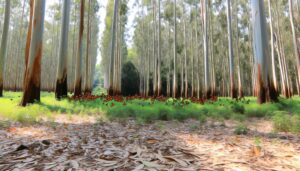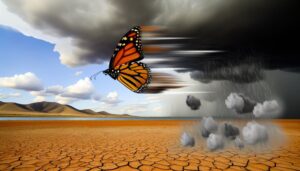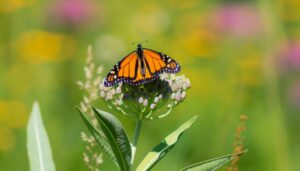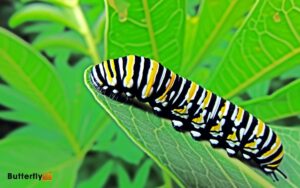Monarch Butterflies and Climate Change: Discover the Impact!
Climate change poses significant threats to monarch butterflies. You’ll see their 3,000-mile migration disrupted by extreme weather events.
Increasing temperatures push their breeding grounds northward while droughts reduce essential nectar sources. Habitat loss from urbanization and agricultural expansion further compounds their survival challenges.
Shifts in climate alter breeding cycles and decrease milkweed availability, important for larvae. The imbalance in ecosystem dynamics impacts pollination and predator-prey interactions.
Conservation efforts and policy advocacy are essential to enhance monarch habitats and guarantee their resilience against climate challenges. If you want to understand the intricate details of these effects, continue exploring.
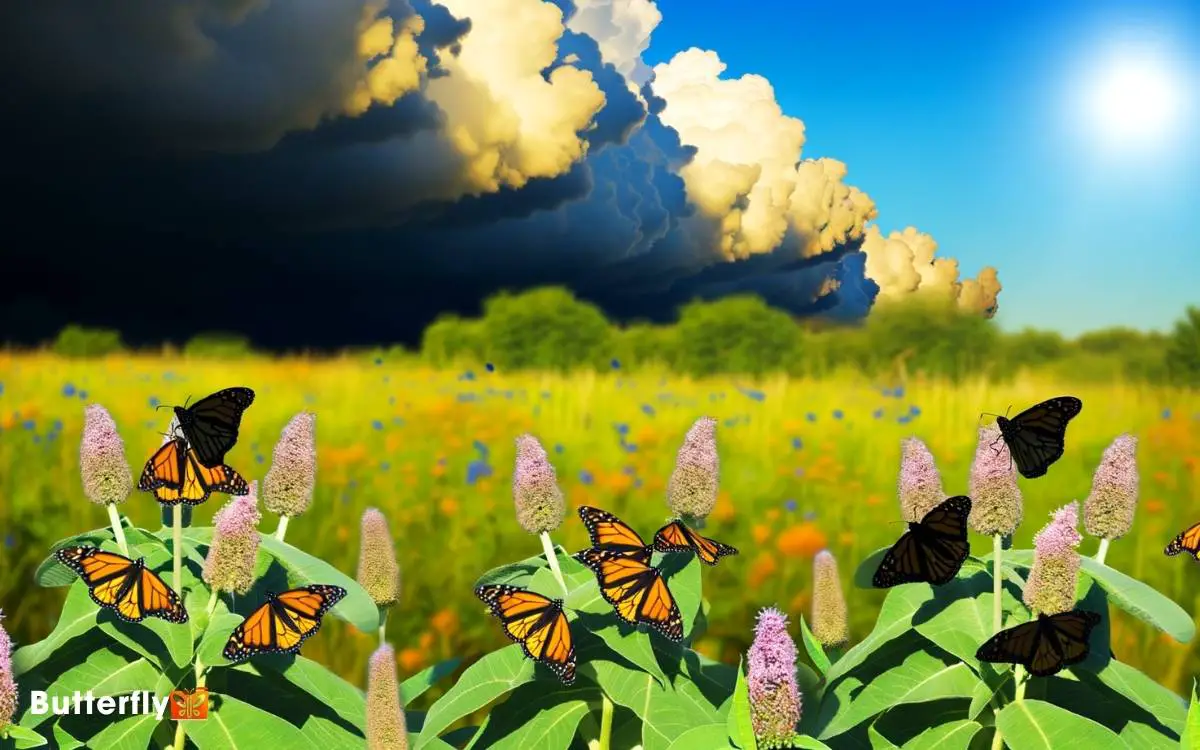
Key Takeaways
Monarch Butterfly Migration
Each year, millions of monarch butterflies undertake a remarkable migration spanning up to 3,000 miles from North America to central Mexico.
You’ll find that these butterflies exhibit a multi-generational migratory pattern. It typically takes four to five generations to complete the round trip.
Monarchs rely on environmental cues like temperature and daylight to navigate. You can observe that they travel at speeds of 12 to 25 miles per hour, covering approximately 50 to 100 miles per day.
This journey is critical for their survival, as they seek overwintering sites in the Oyamel fir forests of Mexico.
You should note that their physiological adaptations, such as fat storage, enable them to endure this long-distance flight.
Changing Weather Patterns
As monarch butterflies begin their arduous migration, changing weather patterns driven by climate change increasingly threaten their survival. Unpredictable temperature fluctuations can disrupt their migratory cues, leading to disorientation and energy depletion.
Studies show that extreme weather events, such as unseasonal storms and cold snaps, can decimate populations. For example, a 2002 storm in Mexico killed an estimated 75% of the overwintering monarch population.
Additionally, drought conditions can reduce the availability of nectar sources critical for their long journey. You must consider how altered precipitation patterns impact milkweed growth, the sole food source for monarch larvae.
These climate-induced stresses compound the existing threats monarchs face, highlighting the urgent need for targeted conservation efforts to safeguard their survival.
Habitat Loss
You’ll notice that habitat loss greatly impacts monarch butterflies due to deforestation and urbanization. Agricultural practices further threaten their habitats by reducing milkweed availability.
Additionally, climate change forces monarchs to migrate, disrupting their established breeding and feeding grounds.
Deforestation and Urbanization Impact
Deforestation and urbanization are primary causes of habitat loss for monarch butterflies, greatly reducing their breeding and migratory grounds. When you cut down forests, you eliminate vital milkweed plants, which are essential for monarch larvae.
Urban sprawl consumes land that once supported these habitats. Studies show that forest loss in Mexico, where monarchs overwinter, has decreased by 2.7% annually.
Urbanization in the U.S. and Canada further fragments these habitats, making it harder for butterflies to find suitable areas.
You can see the direct impact monarch populations have declined by over 80% in the past two decades. Addressing deforestation and controlling urban expansion are essential steps to safeguard the survival of these migratory insects.
Agricultural Practices Threaten Habitats
Agricultural practices pose an additional threat to monarch butterflies by converting native habitats into farmland, thereby diminishing the availability of milkweed and nectar plants essential for their survival.
When you replace prairies with crops like corn and soy, you directly reduce the monarchs’ breeding grounds. Studies indicate that over 90% of the U.S. milkweed habitat has been lost due to agricultural expansion and herbicide use.
Pesticides further compromise these areas by killing non-target species, including critical pollinators. Additionally, monoculture farming practices lack the diversity needed to support a healthy ecosystem.
By understanding and mitigating these agricultural impacts, you can help preserve important habitats and secure the monarch’s continued survival amidst growing environmental pressures.
Climate Change-Induced Migration
Climate change is forcing monarch butterflies to shift their migratory patterns, exacerbating habitat loss and threatening their survival.
As temperatures rise, you’ll notice these butterflies are migrating earlier and traveling further north. These shifts disrupt their reliance on milkweed plants, essential for laying eggs and feeding larvae.
Data shows a 90% decrease in monarch populations over the past two decades, correlating with increased climate instability. Additionally, extreme weather events, such as heavy storms and droughts, destroy critical roosting sites in both overwintering and breeding grounds.
You can see how these changes reduce suitable habitats, making it harder for monarchs to complete their life cycles. Immediate conservation actions are essential to mitigate these impacts and safeguard their survival.
Breeding Ground Shifts
Shifting northward in response to warming temperatures, monarch butterfly breeding grounds are experiencing significant alterations in their geographic distribution.
You’ll find that these shifts are driven by rising temperatures that make southern regions less important for reproduction. Data indicates a 200-mile northward migration in some populations over the past few decades.
This movement affects the timing of breeding cycles and the availability of milkweed, the primary food source for larvae.
Research shows that best breeding conditions are now found in areas with cooler climates. By tracking these changes, scientists can better predict future shifts and guide conservation efforts.
Understanding these alterations is essential for preserving the species, as their traditional habitats continue to transform.
Impact on Ecosystems
As monarch butterflies adjust their breeding grounds, ecosystems face disruptions in plant-pollinator interactions and predator-prey dynamics.
You’ll see changes in local flora, as milkweed, the primary host plant for monarch larvae, becomes scarce in some areas and overabundant in others. This shift impacts pollination patterns, leading to reduced plant biodiversity.
Here’s a snapshot of the cascading effects:
| Disruption | Affected Species | Consequence |
|---|---|---|
| Altered Pollination | Native Wildflowers | Decreased Seed Production |
| Reduced Milkweed | Monarch Larvae | Lower Survival Rates |
| Predator-Prey Imbalance | Insectivorous Birds | Food Source Reduction |
| Habitat Fragmentation | Small Mammals | Declining Populations |
These ecosystem alterations compel you to contemplate the intricate web of dependencies, emphasizing the delicate balance within natural habitats.
Conservation Efforts
You should focus on habitat restoration projects, which have shown a 30% increase in monarch populations in targeted areas.
Community involvement programs are vital, as they enhance public awareness and participation in conservation activities.
Additionally, policy advocacy initiatives aim to secure legal protections, ensuring long-term sustainability for monarch habitats.
Habitat Restoration Projects
Implementing habitat restoration projects is essential for stabilizing monarch butterfly populations threatened by climate change.
You can contribute to these efforts by focusing on three critical areas:
- Milkweed Planting: Monarchs exclusively lay eggs on milkweed. Restoring these plants can greatly enhance their reproduction rates.
- Pesticide Reduction: Reducing pesticide use in critical habitats helps prevent the destruction of both milkweed and nectar sources.
- Habitat Connectivity: Creating and maintaining corridors between habitats guarantees monarchs can safely migrate and find resources.
These strategies are data-supported and crucial for reversing the alarming decline in monarch populations.
Community Involvement Programs
Local communities play a pivotal role in conservation efforts aimed at protecting monarch butterflies from the impacts of climate change. Your participation in planting milkweed and nectar plants can greatly improve monarch habitats.
Citizen science projects, like Monarch Watch, encourage you to track and report sightings, providing essential data for researchers. Educational workshops can raise awareness and equip you with the knowledge to make a difference.
Additionally, you can support local conservation organizations through donations or volunteer work. Studies show that community-driven initiatives can increase monarch survival rates by up to 70%.
Policy Advocacy Initiatives
Advocating for strong policy measures is essential to bolster conservation efforts and mitigate the adverse effects of climate change on monarch butterfly populations. You can influence this by supporting legislative actions that focus on habitat preservation and climate resilience.
Consider these urgent steps:
- Support Pollinator Protection Acts: These acts fund critical research and habitat restoration projects.
- Promote Sustainable Agricultural Practices: Reducing pesticide and herbicide use can greatly increase monarch survival rates.
- Endorse International Conservation Agreements: Monarchs migrate across borders, necessitating cooperation between nations for effective conservation.
Your advocacy can drive these initiatives, ensuring monarch butterflies not only survive but thrive amid escalating climate challenges. By backing scientifically grounded policies, you’re contributing to a sustainable future for these iconic insects.
Future Outlook
The future of monarch butterflies depends greatly on how global temperatures and weather patterns evolve in the coming decades.
You should consider that climate models predict a 2-4°C increase in global temperatures by 2100. This shift could disrupt the monarchs’ migratory patterns and breeding cycles.
If habitats deteriorate, milkweed availability, essential for larvae, will decline. You’d also notice that extreme weather events, such as droughts and storms, could further endanger populations.
To mitigate these risks, conservation strategies must incorporate climate resilience. By supporting habitat restoration and reducing greenhouse gas emissions, you can help safeguard monarchs.
Monitoring and adaptive management will be essential in responding to these environmental changes effectively. Your actions today will shape their survival tomorrow.
Conclusion
You’ve seen how monarch butterflies face threats from changing weather patterns, habitat loss, and shifting breeding grounds. These factors strain ecosystems, disrupt migration, and jeopardize survival.
Conservation efforts, while promising, need scaling. You must advocate for sustainable practices, support habitat restoration, and back scientific research.
Together, we can mitigate climate change impacts, preserve biodiversity, and guarantee monarch butterflies continue their extraordinary journeys for generations to come.

